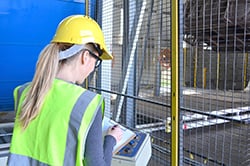 Ill-fitting personal protecetive equipment (PPE) endangers your workers. Are you helping your employees find the right fit?
Ill-fitting personal protecetive equipment (PPE) endangers your workers. Are you helping your employees find the right fit?
If PPE does not fit properly, it does not function as it should. It can therefore expose workers to health and safety risks. It can also negatively impact a worker’s ability to efficiently perform their job. If a worker’s gloves are too big they may put them at risk to getting a glove stuck in machinery or perhaps the loss of dexterity will prevent them from doing their job as well. Likewise, if their hard hat is constantly falling off as they look up, that not only endangers the worker’s head but slows them down as they keep putting the hat back on or use one hand to hold it.
Even though only a small portion of workers in industries such as construction are women, that shouldn’t stop employers and manufacturers from looking into appropriate PPE for women. As quoted in Safety & Health Magazine, Leah Curran of the National Association of Women in Construction shared: “Since the industry is majority employed by men, the majority of PPE is going to fit men, but that doesn’t mean PPE shouldn’t be made to fit women. Women may face safety risks because PPE and clothing are often designed for the average-sized [man].”
Many manufacturers have ramped up their selection of PPE to include items created specifically for women, though some will say the collection needs to continue to be expanded. But it is also the responsibility of employers to ensure they are providing their workforce with equipment geared towards each gender, not just unisex products.
OSHA recommends employers purchase PPE items in ranges of sizes to be suitable for their female workforce. Additionally, they advise employers to keep a directory of PPE manufacturers and suppliers who offer a wide selection of sizes, including equipment geared towards women. This can make it easier to find the appropriate items when it is time to order, leading to greater accessibility for workers. The International Safety Equipment Association provides a list of manufacturers who offer PPE in sizes appropriate for women in the construction industry.
In “Personal Protective Equipment For Women, Addressing The Need”, the Industrial Accident Prevention Association and the Ontario Women’s Directorate offer tips for female workers in their search for proper fitting PPE:
- Earplugs – Disposable, foam earplugs are more likely to fit women, who typically have smaller ear canals.
- Hard hats – Adding a chin strap can help hard hats or caps fit better and not fall off.
- Safety goggles – Beware of goggles that state “one size fits all” – some may be too large for a woman’s face and could allow objects, fluids, or other hazardous materials to enter through gaps in the seals.
- Protective clothing – Taking a man’s garment and modifying it to fit a woman, such as rolling up sleeves or pant legs, can be dangerous because the excess material can become caught in machinery.
- Safety gloves – Ensure all exposed skin is covered; the gloves allow for a safe grip so tools will not easily slip out of the hands; and the finger length, width, and palm circumference of the gloves match those of the hands.
Don’t forget: one size does not fit all! In order to properly protect your workers, be sure you are providing PPE that can fit comfortably and keep people safe, regardless of their size or gender.



